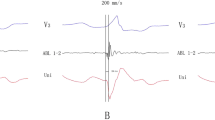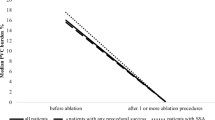Abstract
Purpose
We sought to clarify the electrocardiographic and electrophysiological characteristics of ventricular arrhythmias (VAs), including idiopathic ventricular tachycardia (VT) and premature ventricular contractions (PVCs), with acute successful radiofrequency catheter ablation (RFCA) at the left ventricular basal inferoseptum recess near the mitral annulus (LV-BIS-MA).
Methods
Twenty-five patients with acute successful RFCA at the LV-BIS-MA were included in this study.
Results
The S-wave amplitudes on lead III during VAs were 1.54 ± 0.38 mV, significantly larger than those on lead II (0.55 ± 0.19 mV) and aVF (1.04 ± 0.31 mV) (P < 0.01). Precordial R/S > 1 transition before lead V2 and S-waves in lead V6 was recorded in 100% and 48.0% of patients, respectively. The earliest bipolar activation preceded the QRS onset by 32.3 ± 11.5 ms. Pace mapping demonstrated perfect QRS morphology matching in only 56.0% of patients. The RFCA start-to-effect time was 10.2 ± 5.8 seconds (s) in 21 patients (84.0%). In the remaining 4 patients (16.0%), the mean duration of successful RFCA was not well determined due to the infrequent presence of clinical VAs during ablation. The trans-septal approach was utilized in all 25 cases. Intra-cardiac echocardiography (ICE) showed that the ablation catheter tip was underneath the anterior leaflet of the mitral valve via the reversed C-curve technique. Early (within 3 days) and late (1 year) recurrence rates were 4.0% (one patient) and 12.0% (three patients), respectively. No complications during RFCA or at the 1-year follow-up.
Conclusions
LV-BIS-MA VAs are a subgroup of idiopathic VAs with distinctive ECG and EP features. RFCA via a trans-septal approach using a reversed C-curve technique is effective for better identification and targeting of the areas of VAs origin, and ICE showed that the ablation catheter tip was underneath the anterior leaflet of the mitral valve.




Similar content being viewed by others
References
Cronin EM, Bogun FM, Maury P, Peichl P, Chen M, Namboodiri N, et al. 2019 HRS/EHRA/APHRS/LAHRS expert consensus statement on catheter ablation of ventricular arrhythmias: Executive summary. Heart Rhythm. 2019;59:81–133.
Tada H, Ito S, Naito S, Kurosaki K, Kubota S, Sugiyasu A, et al. Idiopathic ventricular arrhythmia arising from the mitral annulus: a distinct subgroup of idiopathic ventricular arrhythmias. J Am Coll Cardiol. 2005;45:877–86.
Wasmer K, Köbe J, Dechering DG, Bittner A, Pott C, Mönnig G, et al. Ventricular arrhythmias from the mitral annulus: patient characteristics, electrophysiological findings, ablation, and prognosis. Heart Rhythm. 2013;10:783–8.
Kawamura M, Arai S, Gokan T, Yoshikawa K, Ogawa K, Ochi A, et al. Idiopathic basal crux ventricular arrhythmias with left bundle branch block and superior axis: a comparison with inferior-septal valvular arrhythmias. J Cardiovasc Electrophysiol. 2019;30:1914–22.
Sato E, Yagi T, Ishida A, Mibiki Y, Yamashina Y, Sato H, et al. Idiopathic ventricular arrhythmias arising from the posterior septum of tricuspid and mitral annuli: comparison of electrocardiographic characteristics and outcomes of catheter ablation. J Interv Card Electrophysiol. 2019;54:125–34.
Mountantonakis SE, Vaishnav AS, Jacobson JD, Bernstein NE, Bhasin K, Coleman KM, et al. Conduction patterns of idiopathic arrhythmias from the endocardium and epicardium of outflow tracts: new insights with noninvasive electroanatomic mapping. Heart Rhythm. 2019;16:1582–9.
Sun J, Zhang PP, Wang QS, Xu QF, Wang ZQ, Yu Y, et al. Catheter ablation of ventricular arrhythmias originating from the para-Hisian region with reversed C-curve technique. J Cardiovasc Electrophysiol. 2019;30:2377–86.
Liang JJ, Shirai Y, Briceño DF, Muser D, Enriquez A, Lin A, et al. Electrocardiographic and electrophysiologic characteristics of idiopathic ventricular arrhythmias originating from the basal inferoseptal left ventricle. JACC Clin Electrophysiol. 2019;5:833–42.
Yanni J, Boyett MR, Anderson RH, Dobrzynski H. The extent of the specialized atrioventricular ring tissues. Heart Rhythm. 2009;6:672–80.
Tawara S. The Conduction System of the Mammalian Heart. An Anatomico-Histological Study of the Atrioventricular Bundle and the Purkinje Fibers. London: Imperial Collage Press; 2000.
Inoue S, Becker AE. Posterior extensions of the human compact atrioventricular node: a neglected anatomic feature of potential clinical significance. Circulation. 1998;97:188–93.
McGuire MA, de Bakker JM, Vermeulen JT, Moorman AF, Loh P, Thibault B, et al. Atrioventricular junctional tissue. Discrepancy between histological and electrophysiological characteristics. Circulation. 1996;94:571–7.
Ashikaga K, Tsuchiya T, Tashiro H, Yamamoto K. Idiopathic ventricular tachycardia originating from the posteroseptal mitral annulus: a case report. J Cardiovasc Electrophysiol. 2006;17:1375–7.
Li A, Zuberi Z, Bradfield JS, Zarif JK, Ward DE, Anderson RH, et al. Endocardial ablation of ventricular ectopic beats arising from the basal inferoseptal process of the left ventricle. Heart Rhythm. 2018;15:1356–62.
Kawamura M, Gerstenfeld EP, Vedantham V, Rodrigues DM, Burkhardt JD, Kobayashi Y, et al. Idiopathic ventricular arrhythmia originating from the cardiac crux or inferior septum: epicardial idiopathic ventricular arrhythmia. Circ Arrhythm Electrophysiol. 2014;7(6):1152–8.
Ouyang F, Mathew S, Wu S, Kamioka M, Metzner A, Xue Y, et al. Ventricular arrhythmias arising from the left ventricular outflow tract below the aortic sinus cusps: mapping and catheter ablation via trans-septal approach and electrocardiographic characteristics. Circ Arrhythm Electrophysiol. 2014;7:445–55.
Author information
Authors and Affiliations
Corresponding author
Ethics declarations
This study was approved by the TEDA International Cardiovascular Hospital ethics committee for clinical research. All patients provided written informed consent.
Conflict of interest
The authors declare no conflicts of interest.
Additional information
Publisher’s note
Springer Nature remains neutral with regard to jurisdictional claims in published maps and institutional affiliations.
Rights and permissions
About this article
Cite this article
Di, C., Gao, P., Wang, Q. et al. Electrocardiographic and electrophysiological characteristics of idiopathic ventricular arrhythmias with acute successful ablation at the left ventricular basal inferoseptum recess near the mitral annulus. J Interv Card Electrophysiol 66, 281–290 (2023). https://doi.org/10.1007/s10840-021-00983-3
Received:
Accepted:
Published:
Issue Date:
DOI: https://doi.org/10.1007/s10840-021-00983-3




